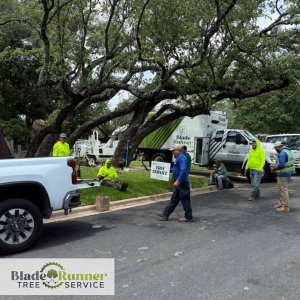Live Oak Tree Restoration in Travis County, TX
It started like many Central Texas tree stories: an aging live oak, a concerned homeowner, and Texas weather doing what it does best—testing every root, leaf, and limb. Down in South Austin, one family noticed their backyard shade tree wasn’t looking too hot. Sparse canopy. Mushrooms. Something felt off.
They called us—Blade Runner Tree Service—to check it out. What followed was a 6-month journey of science, care, and plain ol’ determination to save a piece of neighborhood history without chopping it down.
Blade Runner Tree Service
Based in Travis County, TX
ISA Certified Arborists | Fully Insured
Serving Austin, Dripping Springs, Bee Cave & Beyond
The Goal: Save the Shade Without Cutting Corners
The property had been home to this live oak for nearly 60 years. The canopy once cooled the entire yard. The kids hung swings from it. The dog circled its roots each summer. But lately… it just didn’t look healthy.
Our mission: determine if removal was necessary—or if we could restore this stately oak using arboriculture best practices.
Live oaks (Quercus virginiana) can live upwards of 300 years in the right conditions. Soil health and careful pruning make all the difference.
What We Did—and Why It Worked
Our team arrived with Air Spades, soil kits, mycorrhizal treatments, and sterilized pruning tools. Here’s how we revived this Central Texas tree:
- Root Collar Excavation: Removed heavy mulch and soil packed over the root flare.
- Soil Aeration: Used air spade to reverse compaction and help oxygen flow.
- Mycorrhizal Inoculation: Boosted fungal partners in soil for better nutrient uptake.
- Strategic Pruning: Carefully removed deadwood using ANSI A300 standards.
- Fungicide Spot Treatments: Treated root rot patches and corrected drainage runoff.

“Blade Runner Tree Service didn’t pressure us into cutting our oak down. They taught us how to care for it. Six months later and it’s thriving again.” – Austin homeowner
Challenges We Faced
Live Oaks are tough, but Central Texas ecosystems introduce some real hurdles:
- Drought cycles stressing roots
- Soil compaction from backyard foot traffic
- Mulch volcano around the base (a silent killer!)
- Fungal root zones near a downspout spill area
Invasive digging or non-sterile pruning can spread oak wilt fast. Even well-meaning homeowners often cause more harm than good. Always consult a pro!
“It’s not just about saving a tree—it’s about restoring the soil, rerouting water, protecting limbs, and giving that oak better odds for the next 60 years.” — Dave P., ISA Certified Arborist
If your tree has leaf browning, peeling bark, or mushrooms at the base, don’t wait. Get a certified arborist to assess before rot or beetle activity spreads.
Safety, Permits, and Protection
We take tree care seriously. That means safety first:
- Full PPE for our team
- City permits filed for heritage tree status
- Underground utility clearance before air tools engaged
- Wildlife checks for nesting birds and squirrels
Frequently Asked Questions
How long does tree restoration take?
On average, 3–12 months depending on severity of damage and follow-up care. Our live oak client saw full leaf return in 6 months.
Can I prune my tree in summer?
We don’t recommend it—especially not oaks. Summer pruning increases oak wilt risk. Wait until cooler months. Better yet, let us handle it.
Is mulch bad for trees?
No! But it must be applied correctly. Keep mulch away from the trunk and don’t pile it more than 3–4 inches deep around the root zone.
What causes fungal root rot?
Poor drainage, compacted soil, and overwatering can encourage harmful fungal growth in root zones. It limits nutrient uptake and weakens the tree.
Where can I learn more about tree care?
We recommend TreesAreGood.org—a reliable resource from the International Society of Arboriculture.
Because in Travis County—every tree counts.
Your Trees Deserve a Health Check
If your live oak looks stressed, don’t guess—get expert eyes on it.
Visit our Tree Removal Services page for more examples and educational resources.
